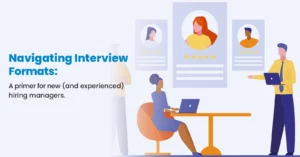Job descriptions are internal documents that clearly outline the essential duties, responsibilities, qualifications and skills required for a project or job. Job descriptions should also define important company details, such as corporate culture, mission, working conditions and any benefits provided. Typically, there are different types of job descriptions depending on the type of job that needs to be filled: non-technical job descriptions and technical job descriptions.
There’s a difference between a job description and a job posting. When an organization identifies the need to acquire full-time or contingent talent, the first step in the hiring process is taken long before the opportunity is presented to the job market. In fact, an often overlooked truth in staffing and recruitment is that the real first step in talent acquisition is taken with the creation of internal job descriptions.
And there’s more than one way to write a job description!
What makes a job description impactful?
Do you want to create job descriptions that work? Before breaking down the different components of a job description by job type, it’s important to first understand the common requirements that must be included in ANY job description. An effective job description will include:
• Purpose: Why does the job exist? How does it serve the organization?
• Primary Duties: What tasks is the worker in this job expected to complete?
• Requirements: What requisites are needed in order to succeed in the job?
• Competencies: Which competencies are needed in this position to excel and thrive within the job?
A great job description will include real-time examples of work the organization is actually doing. When crafting a job description, include a list of projects and teams the successful candidate will be working with. The goal is to clearly detail required tasks in order to demonstrate what it would be like to do the job on a day-to-day basis.
Including these tasks in the job description will help staffing agency partners and hiring teams craft compelling job postings that will bring talent quickly and cost effectively into your organization.
Remember: Use clear job titles in you job description
It’s also important to use a clear job title in your job description. Jobs that are marketed using a non-traditional job title like “Rockstar Developer” in a job description can be considered potentially discriminatory if the same language is used as a job title in an external job posting. Similarly, if you’re looking to fill a Customer Service job but list the opportunity as a “Sales and Marketing Specialist” in the job description, it’s likely to attract the wrong candidates if a disingenuous title is transferred to the external job posting.
Always be transparent in every job description. When the opportunity goes to market, this will help to make sure that your organization is creating a positive candidate experience from the very beginning.
Why is there more than one type of job description?
Job seekers will have different priorities depending on the type of job they’re looking for, and these motivators will have a direct effect on the type of job description recruiters and hiring teams should use.
In order to attract qualified talent to your job opportunity, it’s critical to first identify components of the job that must be optimized in the job description. Once this process is completed, the internal job description can then be crafted and shared with the organization’s hiring team or staffing agency partner in order to create compelling, external job postings.
A detailed job description is the essential first step in recruitment.
Typically, there are two different job descriptions that can be created to share with staffing agency partners and hiring teams: A technical job description and a non-technical job description.
How to write job descriptions
Non-technical job description
A non-technical job description is required for a job that does not require a high level of technical skills. Some examples of these types of jobs include:
• Marketing co-ordinator
• Sales associate
• Social media officer
• Accountant
• Office manager
The overall business goals of a non-technical job type rarely change; they typically also don’t require workers to continuously upskill and/or learn new programming languages or software. As such, when writing a non-technical job description, it’s important to optimize the organization’s company culture, the possible longevity at the organization and the personal nature of the team the successful candidate will be on – along with the required skills and experience.
A non-technical job description must include these components in order to drive the right type of engagement. The job description below is a good example of how to write a non-technical job description.
Technical job description
A Technical job description is required for a job that has a must-have requirement for certain IT skills and direct experience in specific software applications and/or program languages. A technical job description should be used when looking to fill job roles, such as:
• Data Scientist
• Software Developer
• Information Security Analyst
• Computer Systems Analyst
• Web Developer
Technical job seekers will usually be more concerned about the technologies being used and the goal of a specific project rather than the longevity of a project or corporate culture of an organization, so these components shouldn’t be the main focus in the job description. As technologies are ever-evolving, these types of job seekers are motivated to keep their skills sharp in their chosen technology in order to position themselves in the highest possible demand for future engagements.
What version of your technology are you using, and what’s the goal of your job or project?
Including this detail in the job description will help job seekers quickly understand if the job uses their preferred technologies, and if the job aligns with the types of projects they want to specialize in.
A technical job description must include these components in order to attract the right type of candidate. The job description below is a good example of how to write a technical job description.
When crafting job descriptions, always make sure to consider the job type and the candidate motivators behind both These are the key components to crafting job descriptions that attract the talent you want — and need.
The Voice of Talent: Return to the Office Report
Procom recently surveyed over 1,000 knowledge workers to discover how and where they prefer to work as offices re-open across North America.
The Voice of Talent Report offers actionable insights into what workers expect in relation to mandatory vaccinations, remote work preferences, The Great Resignation, COVID-19 safety measures and more.
Access your complimentary copy to discover how to attract talent in a post pandemic world:




